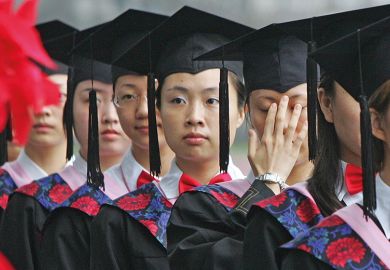Global higher education has become well accustomed to China’s march up university research-based rankings. In the latest Times Higher Education World University Rankings, Tsinghua University became the best-placed university in Asia and five of its seven top 200 universities climbed the list.
But it appears that Chinese universities are not making the same kind of ground for graduate employability, according to a new analysis based on eight years of the Global University Employability Ranking.
According to the analysis – which looks at how countries have fared in the ranking since its first edition in 2011 – China’s overall performance is only slightly better than four years ago and actually fell back this year.
China’s slower trajectory for employability also compares unfavourably with other East Asian nations: South Korea in particular now has almost as many entries in the top 150 of the ranking as China and has almost doubled its number of institutions represented since last year.
Meanwhile, the analysis also illustrates how universities in the US, UK and France have fallen back since 2011, while Germany has bucked the European trend to be second only to the US for the number of universities in the top 150.
This year’s edition of the ranking – which has been published by THE since 2015 but run since 2011 by Paris-based human resources consultancy Emerging and employment research institute Trendence – is still led by US institutions, although there is one fewer in the top 10 compared with last year.
Harvard University comes top, moving up one spot to switch places with the California Institute of Technology. The Massachusetts Institute of Technology and the University of Cambridge both move up one place to third and fourth while Stanford University moves up two, completing the top five.
Global University Employability Ranking 2018: Top 150
Search by institution name or by country to filter by that nation
The wider analysis comes from looking at the relative performance of countries in each employability ranking since 2011. An aggregate score was calculated every year for each country based on the placings of its institutions in the top 150. A university scored 150 points for coming first, 149 for second and so on.
Although the US is still a long way ahead in terms of its overall aggregate score in 2018 – its 34 universities scored just under 3,000 points based on their placings – this is down from having 55 universities in the top 150 in 2011 and a total of more than 4,600 points.
The UK and France meanwhile have fallen from having around 1,500 and 1,200 points respectively in 2011 to scoring less than 1,000 points in 2018. Germany, which had only about 700 points as recently as four years ago, now has almost 1,000 points and more universities (13) in the top 150 than the UK or France.
In Asia, China has the most points in 2018 with just over 500, but this represents only a small rise compared with four years ago. Meanwhile, South Korea has gone from having just 33 points in 2011 to more than 300 in 2018. And combining South Korea, Hong Kong and Singapore would give a total that is far ahead of China.
Lili Yang, a doctoral student in higher education at the University of Oxford and researcher at the Centre for Global Higher Education, said that the results for China were interesting, and may reflect the much longer period of time needed to improve graduate employability.
She compared this to China’s slower improvement for research performance in the arts and humanities, which also required more time given that it did not benefit from the “massive financial investment and institutional support” that had helped science subjects.
“Improving graduates’ employability is similar in terms of its requiring a much longer time. Unlike producing research publications or patents, cultivating students – for example undergraduates in Chinese universities – is a process of four-year efforts,” she said.
“Such significant increases in scores, like Chinese universities’ research performance did in the past several years, can hardly be copied in graduates’ employability.”
Ms Yang added that Chinese universities had also started “internationalisation and building students’ global competence with a much weaker foundation” compared with other East Asian states such as Hong Kong or South Korea.
Jisun Jung, an assistant professor in the Faculty of Education at the University of Hong Kong, said that in her view the reasons for China’s slow progress may be differing learning and teaching styles.
“Employers today emphasise ‘transferable skills and soft skills’ more and more, but that part is lacking in Chinese universities,” Professor Jung said.
She added that the long history of Soviet higher education influence in China meant that subject knowledge was “very narrowly specialised with several compulsory courses [and] without much choice [for] students. That curriculum structure does not match with current employers’ demands such as cross-disciplinary thinking.”
A differing attitude in China towards soft skills is also evident in responses from employers recorded by the 2018 Global University Employability Survey that underpins the ranking, which this year focused on university-industry collaboration.
Firms in China answering the survey placed a much greater emphasis on graduates having hands-on experience, with 76 per cent rating hard skills as a very important factor for success and 67 per cent rating soft skills as very important.
But in the US, most European countries, Japan and South Korea, this view was reversed with a greater share of firms emphasising soft skills as being very important.
There was also a noticeable difference in the emphasis placed on graduates having critical thinking skills between countries in East Asia and Europe or North America. For instance, in the US more employers (90 per cent) rated this as very important than in China (75 per cent), where adaptability and collaboration were more likely to be seen as vital skills.
Laurent Dupasquier, associate director of Emerging, said that in general the most interesting trend in the ranking over the past few years had been the decline of US dominance.
“They were streets ahead in the US…but now everyone has caught up. Other nations now have top universities that without any problems can compete with the best US universities and that was not the case 10 or 15 years ago,” he said.
Mr Dupasquier said that Germany’s rise had been a standout development, something he attributed to actual graduate employability having more influence on voting patterns over time than universities' reputations.
“The Americans are very good at marketing themselves…sometimes there is a triumph of style over substance. But you could say the opposite about Germany. They are not the best marketers on the planet but they are very good on substance.”
Christian Tauch, head of the education department at the German Rectors’ Conference, said that there had also been a big debate in the past few years in Germany about how to focus more on employability in subjects that traditionally may not have had that emphasis.
Universities of applied sciences (Fachhochschulen) had always been strong on this, as too had technical disciplines in universities, but perhaps not humanities or social sciences departments, he added.
“One issue that has been on everybody’s minds…has been exposing students to practical experience and that certainly has intensified in the past few years,” he said.
The huge growth in international students in Germany may also have been a factor in the country’s reputation spreading, Mr Tauch said, with such students returning home and “spreading the good news that they are, apparently, happy with their degree”.
simon.baker@timeshighereducation.com
Global University Employability Ranking 2018 methodology
To produce the Global University Employability Ranking, an online survey was completed by two panels of participants between May and September 2018.
The panels included respondents from 22 countries: Argentina, Australia, Brazil, Canada, China, France, Germany, India, Israel, Italy, Japan, Mexico, Morocco, the Netherlands, Singapore, South Africa, South Korea, Spain, the United Arab Emirates, Sweden, the UK and the US.
Both panels amounted to a total of about 7,000 respondents who casted around 75,000 votes for universities they felt were the best for graduate employability. Together they represent employers that have recruited more than 250,000 young graduates in the past 12 months.
The first panel, which also filled out a survey on graduate skills for future jobs, consisted of recruiters at management level with at least five years’ experience hiring or working with graduates. The second panel consisted of managing directors of international companies.
Participants of the two panels could not vote for any university in their own country. Votes were aggregated into scores for each university to produce the ranking.
The sample size of recruiters from each country was determined by the nation’s student population, GDP and number of higher education institutions.
The survey was designed by the French human resources consultancy Emerging, and has been conducted for the past eight years by employment research institute Trendence. It has been published exclusively by Times Higher Education since 2015.
This year an increased number of votes allow for a “challenger” list of institutions placed between 150 and 250 in the ranking to also be published in two bands (see below).
Global University Employability Ranking 2018: Challengers
POSTSCRIPT:
Print headline: China falls behind on employability
Register to continue
Why register?
- Registration is free and only takes a moment
- Once registered, you can read 3 articles a month
- Sign up for our newsletter
Subscribe
Or subscribe for unlimited access to:
- Unlimited access to news, views, insights & reviews
- Digital editions
- Digital access to THE’s university and college rankings analysis
Already registered or a current subscriber? Login








